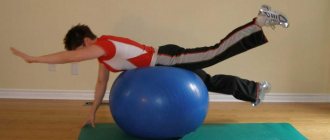“Strength endurance is the body’s ability to perform work with maximum power impulses for a long time without reducing strength.
Let's consider this concept using the example of two people: a beginner who recently started working out in the gym 1-2 times a week, and a more experienced fitness club visitor who has been training regularly for 2-3 years - 2-3 times a week. The first, performing 8 repetitions of bench press with a weight of 90 kg, will do less and less with each approach, losing strength. The second, after the first approach, will continue to press the same weight with the same number of repetitions. His strength endurance is much higher than that of a beginner. He has more experience in training, the body is adapted to the load, due to which creatine phosphate is accumulated in the muscle tissue - a substance that is used as a resource for muscle contractions and powerful impulses. It can be produced by the body (this is “first aid” for muscles after stress caused by exercise) or come from food.
Strength endurance can only be developed over a period of training and only with significant working weight. With an average weight, a person does not work at full capacity, which means that it will not be muscle endurance that will develop, but the overall endurance of the body. Muscular endurance is developed only if the training process is based on the strength method - not with medium or light weights.
- In strength training, perform 5-6 repetitions with heavy weights, with plenty of rest time between sets.
- Workouts to develop general endurance include sets of 20-30 repetitions with light weights.
- Strength endurance training involves serious weight and about 12-20 repetitions.
With the development of strength endurance, the number of repetitions is increased without reducing the working weight; If you manage to work with it for a longer time, then muscle endurance increases.
The more training experience, the better the innervation of the muscles - the “brain-muscle” connection. Its development is easy to imagine for those who know how to ride a bicycle: once you learn it, you never forget it. The more often you ride, the better your technique, the less effort it takes, the more time you can move at a higher speed. It’s the same with the work of muscles, which are surrounded by motor neurons that transmit signals to the brain and back. With a longer training period, the connection between the brain and muscles is higher - muscle fibers contract more powerfully and efficiently.
However, even with good neuromuscular connection, the muscles will not be able to cope with the “heaviest” final repetitions at the end of the sets; To do this, it is necessary that the muscles have enough of such a resource as creatine phosphate - it is through it that muscle strength and endurance increases. During training, adapting to the load, the body accumulates this substance to reduce stress during further muscle work.
What is endurance
When talking about a set of exercises for developing endurance, many trainees actually mean different things. “Endurance is the body’s ability to work for a long time without a noticeable decrease in performance,” says Anastasia Yurkova, master trainer at X - Fit in Russia .
— At the same time, general and special endurance are distinguished. General endurance involves the efficient performance of any moderate-intensity work, such as walking. But special endurance is the body’s ability to endure prolonged loads under certain conditions. For example, when performing anaerobic, that is, strength, exercises. In turn, special endurance is divided into subtypes, including strength endurance. This is the ability to do strength exercises with the correct technique for a long enough time, without signs of fatigue.” Thus, if they tell you: “These are exercises for developing endurance,” always clarify: “What kind of endurance?”
What kind of endurance is there?
It is not difficult to remember the division of this quality.
There are two types of stamina: general and special.
- General endurance - the ability to walk, ride a bike, swim, run for a long time. Not fast, not on difficult terrain, but just move - with a low heart rate and not particularly tired.
- But special endurance is divided into: Difficult coordination - you can do exercises that require good coordination for a long time, for example, dancing or playing football;
- High-speed - you can walk, run or pedal quickly for a long time;
- Speed-strength - you can run a series of sprints or jump rope for a long time without losing momentum;
- Strength - you can do exercises with significant weights, repeating cycles at minimal intervals.
“It should be noted that sometimes the division is very arbitrary,” says Dmitry Lapkin, fitness trainer, host of the online fitness project Fit & Well . - For example, if you do push-ups at a fast pace, this can be classified as speed-strength endurance. If you do push-ups for a long time, efficiently, but it’s too hard for you to do it at a fast pace, this is already strength endurance.”
Run
This exercise is probably the most common. Many people simply underestimate it or do it wrong. Here's what you need to keep an eye on:
- The body must have time to recover. Running every day is not recommended. The best option is every other day. However, you shouldn’t take a break for more than two days either.
- There should be enough breathing, so watch this carefully.
- If you are a beginner and have not run before, it is better to start with walking. This, by the way, is also a very useful activity, thanks to which strength endurance is excellently developed. Race walking is even included in the list of disciplines of the Olympic Games. The main thing is to maintain a fast pace. Then you can go to light jogging for literally five minutes a day, gradually increasing the time.
- Cardio training should have varying intensity. At first we run slowly, accelerate and slow down again.
Who benefits from developing strength endurance?
For those whose goal is a strong and healthy body. “Thanks to good strength endurance, the practitioner gets a beautiful body contour, a strong myocardium (heart muscle), and, therefore, good functioning of the cardiovascular system,” says Anastasia Yurkova. “This is a great option for those who want to gain muscle mass while maintaining heart and vascular health. True, it is often more difficult for women to develop strength endurance, as well as strength indicators in general, since the female body is less adapted to power loads.”
By and large, strength endurance is the ability of muscles not to get tired for a long time. And don’t get tired not just from movement (as with general endurance), but when you lift, carry, or pull something.
In the process of developing this quality, our muscles learn to quickly and effectively restore creatine phosphate reserves in the muscles. This is the energy substrate into which glycogen and fats are ultimately processed. It is creatine phosphate that allows you to quickly put a lot of muscle fibers into work and lift a lot of weight. In a person with good strength endurance, creatine phosphate is synthesized better.
In addition, such people work their muscles more consistently during exercise and have developed the correct technique for performing exercises. This is what helps them not get tired, that is, to be more resilient during strength exercises.
How to develop endurance?
General endurance is most often trained using classic aerobic exercises: group aerobics, running, fast or Nordic walking, cycling, skiing, skating. “For strength endurance, training is definitely with weights, and quite a lot - from 50% of one repetition maximum,” says Anastasia Yurkova. “Otherwise, you will simply develop endurance without strength indicators.”
Thus, developing endurance through long exercise with light weights will increase overall endurance, not strength. “The weight of your own body can also be a big burden,” adds Dmitry Lapkin. “For example, it’s easy for a trained person to do 15 push-ups; this is an exercise for general endurance. To increase his strength, he needs to do push-ups on parallel bars or with a barbell plate on his back. A beginner may be able to do only one push-up in the first approach, in the second he only has enough strength for six push-ups, in the third it’s good if he does three. In this case, push-ups are affordable endurance exercises for him at home.”
Training according to all the necessary rules
In order for the classes not to be in vain, it is necessary to follow a number of certain rules (especially for beginners in this matter).
- During the training process, you must rest. Between sets or between exercises, it doesn’t matter. It would be great if the breaks were not completely passive, for example, heavy exercises would be replaced by easier ones. This will make it easier for the body to cope with stress, and at the same time, the workout will become more productive.
- It is necessary to train endurance every day, starting from about fifteen to twenty minutes. Gradually the time increases. It is important to emphasize: gradually! The maximum time should not exceed sixty minutes.
- Don't confuse strength training with endurance training. This is a completely different set of exercises that should be separated. It is optimal if a day passes between them.
- And, perhaps, one of the most important conditions. Training should bring joy and pleasure; you should not perform the exercises with all your might and bring yourself to a state of fainting.
Endurance exercises
Any endurance requires that the body effectively uses oxygen and no less successfully cleanses the blood of carbon dioxide. The higher the load, the more energy production waste in the blood - lactic acid and other products that appear when creatine phosphate is produced, and then energy from it. Endurance exercises, in addition to muscles, train the blood and lungs, helping them carry out all their biochemical processes more successfully. To do this, muscles and other cells begin to produce enzymes more efficiently and synthesize various compounds that are involved in these processes.
Walking on a treadmill
Traditionally, general endurance is trained in this format. But you can change the angle so that the machine turns into a “mountain” and pick up dumbbells. This type of walking will bring you closer to strength training for your legs or even your entire body.
Run
Running is traditionally considered an aerobic exercise. In fact, beginners often run at too high a heart rate, meaning their intensity is more suitable for barbell training. If you include long accelerations in your jogging, you will receive strength training in addition to aerobic training. Repeating such a run should be done no more often than every other day, or even less often.
Jumping rope
This jumping exercise is more of a speed-strength exercise. It is successfully used in many sports (boxing, wrestling) precisely to develop the ability to fight for a long time. However, keep in mind that jumping is a high load not only on the muscles, but also on the knee, hip joints and lumbar spine. It is not advisable to include jumping in your training plan more than once every 3 days.
Squats
A classic strength exercise that uses a barbell, dumbbells or kettlebells. The whole body is involved in the exercise, with the lower limbs, buttocks and back working dynamically, and the abs, lower back and upper shoulder girdle working statically. Due to this combination of load, the exercise gives a high load and ideally trains strength endurance. If you do not have weights at your disposal, you can use, for example, plastic cans of water. Or squat on one leg, performing 6-10 reps on each side. In this case, the load in each movement will increase by approximately 50%.
Developing strength and endurance with dumbbells
These apparatuses are used for squats and lunges. There are also a lot of exercises for the back, chest and upper shoulder girdle - presses, fly-ups while lying down, sitting and standing, side and front raises, bent-over abdominal rows. If you perform these exercises with a small (up to 5-7 kg) weight, then they train overall endurance. If you work with weights more than 5-10 kg, then you develop strength. First, do exercises for the back and chest, take the heaviest dumbbells for the back, and slightly smaller ones for the chest. For the shoulders, use slightly less weights than for the pectoral muscles. For arm exercises (triceps extensions and biceps curls), use even lower weights than for the shoulder muscles. At the same time, all weights should require effort from you when working, otherwise you will not be able to develop strength endurance.
Pushups
Another complex exercise where the legs and abs work in a static mode, and the muscles of the upper shoulder girdle, chest and upper back contract. It can be aimed at improving strength endurance if it really forces you to tense up and make an effort to maintain the quality of your performance. If 15-20 push-ups per set are easy for you, it is better to switch to dips, push-ups with weights on the body, or barbell or dumbbell presses while lying on your back. These exercises train approximately the same muscles, but they are more complex.
Burpee exercise
One of the hardest exercises for the whole body. It is a sequence: squatting - throwing your legs back with a jump - push-ups - pulling your legs to your arms with a jump - jumping up. It is advisable to do it at speed. Depending on the degree of preparedness of a person, it is aimed at improving either the strength or speed-strength component. For untrained people, it is better to perform the burpee elements separately to avoid injury.
Kettlebell exercises for endurance
This not the most popular equipment provides training opportunities that neither a barbell nor dumbbells can provide. Its peculiarity is that the projectile is taken by the upward handle and hangs down, as it were. Exercises are done with a kettlebell while sitting and standing, usually with one hand at a time. At the same time, due to the specific grip and shape of the weight, the body and legs are actively involved in the static work of maintaining balance.
Plank
The well-known exercise is used to develop strength endurance in a dynamic version. In other words, you should take the initial plank position, and after a certain time interval (from 30 seconds to 2 minutes), without dropping to the floor, move to the side plank position. Then, in exactly the same way, change the position to a straight or reverse plank, from which to make a side one in the other direction. In addition to strength endurance, complex coordination endurance will also develop.
Crossfit complexes
In fact, CrossFit is a discipline, the whole essence of which is strength and speed endurance. By doing CrossFit, you improve them. By improving them separately, not as part of functional complexes, you increase your potential in CrossFit.
The complexes given below are both aerobic and anaerobic in nature. By doing them, you become stronger and more resilient. See for yourself.
| Masters Final 11 | Perform 500 meters of rowing, 500 meters of cycling, 15 box jump burpees and a 110 meter shoulder carry. Needs to be done as quickly as possible. |
| McKinnon | Do a 2.5K run, 5K rowing, 7.5K cycling, and another 2.5K run. Needs to be done as quickly as possible. |
| Pedal to the Metal | Perform 12 handstand push-ups, burn 24 calories on the rowing machine, 16 calories on the stationary bike, then perform 8 deadlifts. The goal is to complete the maximum number of rounds in 7 minutes. |
| Regional Individual Event 6-16 | Perform 1km spin on a stationary bike, 30m hand walk, 10 overhead squats, 500m rowing machine, 50 box jumps and 5 overhead squats. The goal is to complete the maximum number of rounds in 20 minutes. |
What else do you need to know about developing endurance?
By exercising to improve strength endurance, it is quite possible to lose weight. “If you follow the principles of rational nutrition, it is possible to reduce body fat mass,” explains Anastasia Yurkova, “but on the scales, it is likely that you will see an increase in numbers. The fact is that muscle is heavier than fat. Therefore, with an externally different body quality, the number on the scale may not change or even increase if you initially had a little body fat. In general, whether you lose fat or not depends on the calorie content of your diet.”
In training to develop strength endurance, the number of repetitions is increased to 12-20. It is advisable not to reduce the working weight; If you manage to work with it for a longer time, then strength endurance increases. You can increase the number of repetitions from workout to workout without changing the weight.
“Circuit training is ideal for training general endurance, but is not suitable from the point of view of developing strength indicators,” recommends Anastasia Yurkova. — I recommend performing 3 approaches of one exercise. If you are already prepared in the field of strength training, then it is more effective to use split training. But if fatigue does not yet allow you to work the entire workout, for example, on the legs, you can first use the “fullbody” approach.
Improving strength endurance is actually good preparation for everyday life, where you often have to carry or rearrange something. Especially if you are the mother of a small child, travel often, or simply deal with everyday issues at home.
Basic training program
As noted, strength endurance has nothing to do with strength training. In the second case, the main goal of the athlete is to develop muscle strength, pump them up, and give them the desired shape.
A beginner will not be able to develop such a training program on his own. This should be done by the trainer, taking into account all the characteristics of the human body. In general, any program is based on the fact that the athlete lifts the maximum possible weight for himself, taking long breaks between approaches. Such classes are held several times a week and usually consist of three approaches to each exercise. Basic exercises are squats, bench press, pull-ups, exercises with dumbbells, exercises with a barbell.










